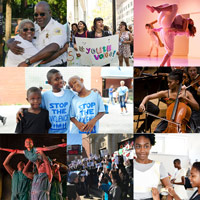Urban Juncture and El Paseo Community Garden use creative placemaking to revive communities in Chicago.
For almost a decade, Paula and Antonio Acevedo have poured their sweat and more into what was once contaminated land in Chicago’s industrial neighborhood of Pilsen.
Their work and that of others has transformed the lot into El Paseo Community Garden—much needed greenspace that instills pride, stewardship, and a sense of community.
About 30 blocks south in Bronzeville, Bernard Loyd, his colleagues, and neighborhood residents use re-purposed shipping containers to spark community development as part of Urban Juncture’s Build Bronzeville initiative.
El Paseo and Urban Juncture are creative placemakers, an emerging movement of organizations seeking to solve community needs by bringing residents together through arts and culture.
“All that we’ve accomplished proves that community gardens can be so much more than veggies,” said Paula Acevedo, who co-directs El Paseo with Antonio. “Our land acts as a community space that provides the opportunity to not only grow healthy food but become an active member of the community and learn from one another.”
Sharing knowledge, she said, also helps bridge cultural and generational gaps.

El Paseo has become a placemaker in part by hosting a variety of community events, including educational gardening workshops, potluck parties, an annual harvest festival, a Halloween haunted garden, pop-up markets, weekly yoga and meditation, and more. The site also provides space for older adults in exercise programs and has a Monarch butterfly garden and honey bee hives.
Its murals are particularly important to community-building. Early in their creation, the organization gathered residents to sketch ideas and select themes. Then the Acevedos enlist local artists to compose images relevant to the neighborhood.
“Our murals continue the traditional mural style of storytelling and activism,” Paula Acevedo said. “And they pay homage to the many Pilsen murals that have been covered up or lost over the years.”
El Paseo also sponsors a mural community day, when volunteers of all ages use a paint-by-number approach to help complete the images.
“That kind of engagement makes people have a sense of pride in their community,” said Paula Acevedo. “Occasionally, we hear people saying, ‘Yeah, I came to their paint day. I helped paint that mural.’ It's truly a beautiful thing to be able to provide the spaces and platforms for the community to come together across all backgrounds and ages.”
The community-driven art projects beautify the neighborhood, and residents’ investment in them instills respect, stewardship, and belonging.
“What’s interesting in Pilsen is that you’re seeing characteristics that might be attributed to artists being demonstrated by people who care about environmental issues, community, and the landscape of the built environment,” said Amanda Williams, a Chicago artist and creative placemaker. “Murals in particular become a very accessible manifestation of collective hands; gardens also.”
Amplifying What’s Here
Established in 2008, Urban Juncture utilizes food to revitalize 51st Street and contribute to the overall revitalization of Bronzeville. The community development organization has launched several initiatives, including an enterprise incubator, center for Black cuisine, community and rooftop gardens and restoration of The Forum.
One of its signature efforts is Boxville, a weekly marketplace run out of shipping containers near the CTA’s Green Line station at 51st Street.


“Urban Juncture is so important,” said Loyd, the organization’s founder and president, “because it builds on local assets, including culture, history, and people, to create locally-owned enterprises that revitalize disinvested communities.”
Bronzeville resident Sandria Washington started as a volunteer with Urban Juncture and then became director of engagement and partnership. She said the organization has brought energy and personality to the neighborhood through its focus on using what already exists in Bronzeville and drawing in residents to participate in planning.
“Everything that Bronzeville needs to thrive is here,” she said. “Through these initiatives, we’re creating more opportunities to amplify what’s here.”
Revitalizing Land and Communities
In Pilsen, a small group of neighborhood gardeners, artists, and designers established what would become El Paseo in 2009. Originally known as Growing Station, it was the first community garden of its size in the neighborhood.
But the land had become contaminated from a neighboring smelting factory and scrap metal dealer that had closed in the early 1950s and a coal plant, among other sources. Between 2009 and 2014, the U.S. Environmental Protection Agency and city of Chicago removed contaminated soil, layered new soil at the industrial site, and remediated El Paseo’s permaculture site.
Today the space, covering slightly more than a half-acre, draws many volunteers who help sustain it.


Social connections and a sense of community forged through networks in places such as El Paseo bring life to neighborhoods that otherwise might be filled with desolate lots, said Chicago architecture expert Lee Bey, a former board member of NeighborSpace. The nonprofit is El Paseo’s land trust and partners with the garden in much of its work.
“The spaces become centers for gathering and for ritual,” Bey said. “The neighbors are involved in the creation of them, and they take stewardship over the areas once they are built.
“It’s important in every neighborhood for the people who live there to feel a sense of belonging over what’s happening around their neighborhood,” Bey added, “what’s being built and created.”
El Paseo is planning to expand to a full acre. Loyd said that in five years, Urban Juncture will be “a must-see visitor destination,” and create 1,000-plus jobs, business ownership opportunities and catalysts for more revitalization.
“And,” he added, “we will have helped to re-knit the social fabric of our neighborhood through creating opportunities for deeper and stronger connections between neighbors.”
Established in 2019, MacArthur’s $15,000 Creative Placemaking Award highlights innovative ways residents and organizations use the arts to bring people together and build the character and quality of place. El Paseo Community Garden received the 2020 award. Urban Juncture was the 2019 recipient. MacArthur also provided the Urban Juncture Foundation with $515,000 in support in 2018.




